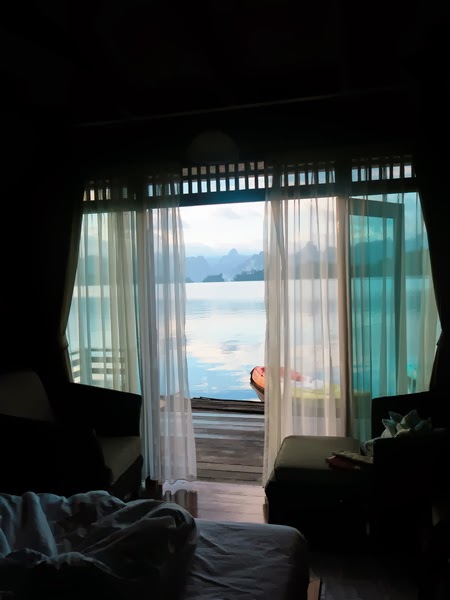 |
Tucked in the deep south of Thailand’s mainland
between the popular western Andaman coast and Samui, Tao, Pa Ngan islands on the
Gulf of Thailand, Khao Sok National Park is a patch of one of the world’s
oldest evergreen rainforest, enclosing limestone karsts shooting up in the air,
emerald-color lakes, rushing waterfalls, rivers running through lush valleys,
glittering limestone caves, and diverse wildlife. Destination Thailand checked
this jungle holiday destination out and found that to describe our travel experience
as being ‘rewarding’ would truly be an understatement.
Khao Sok National Park covers an area of 739 square
km²,
a part of the region’s natural heritage aging over 160 million years. The area
has the highest level of rainfall in Thailand – 3,500 mm per year thanks to the
high mountains and the fact that it is sided by sea, which means even in the
driest season, it still receives enough rainfall for the forests to remain
evergreen.
Species
diversity is high in Khao Sok. There are about 200 different floral species per
hectare and over 415 fauna species. Among these are the rare ones of the smelly
Rafflesia, the biggest flower in Thailand, animals on the country’s list of Wildlife Conservation and Protection Bill such as tapirs,
marbled cats, the loud cicada, the poisonous tarantula, and many more.
Upon our arrival, we checked in at Our Jungle
House, a nature resort on a piece of a privately owned rainforest 5 minutes
from the national park itself. The resort is one of the most eco-friendly
accommodations in Thailand. Their tree houses and cottages made from natural
materials and built within the 25-acre property hardly had to cut any trees. Trails
snaking through the land bring you to your rooms and also lead you to discover beautiful wild trees,
lianas and flowers in the woods growing around the resort. The rooms without air conditioning, hot water, and TVs certainly
reduce carbon emissions yet remain comfy. All waste is sorted into
compost, glass, plastic, metal, and paper which are then reused, and recycled.
Upon waking up on your bed, you’ll be greeted by the sound of wild gibbons and
several types of monkeys while walking out of the room, what maybe waiting at
your balcony is a hornbill. No need to say how quiet and peaceful it is here. You
can never sleep in a well-maintenance guestroom closer to nature than
this.
Once you arrive at Our Jungle House, there are
loads of outdoor and eco activities you can do. Choose among day and night
treks, a rubber boat or tubing trip down a stream, elephant back riding, or the
extended day trip to the nearby Chiew Larn Dam.
At the national park’s head quarter, you can get
really useful information of trekking on the park’s 3 nature trails. Each,
ranging from 2 to 9 kilometers, can be completed as a one-day trip but can as
well be extended if you want to camp in the park’s forest. The trails pass through
waterfalls, rafflesia bushes, bamboo forest, tall canopy trees, and all sorts
of landscapes a rainforest can offer. While some visitors preferring guiding
themselves on the well-marked trails, some hire local trekking guides from
their resorts. We got ours from Our Jungle House and headed to the Bang Hua
Raed – Tone Kloy Waterfalls Trail.
We were told this was a 9-kilometer trail one-way
but definitely could be shortened using shortcuts. It was a fairly easy hike
while khun Kai engaged us with the stories of the forest, the fact about the
area’s flora and fauna, and his excitement when he found something and pointed it
out to us almost every 5 minutes or more frequent. If you’re with a guide, what
you might be seeing the most depends on the subjects your guide is specialized
in, some are insect lovers, some know so much about plants and herbs, and some,
like our guide, are bird-watchers. Every moment was exciting and informative,
just like khun Kai promised us, that if we kept our eyes, nose, and ears open
to the surrounding, and were quick enough to follow his pointing fingers, we
would discovered that every single square meter, there could always be something
waiting to surprise us.
To learn more about Our
Jungle House, visit www.khaosokaccommodation.com and to get some insightful information about the
park, go to www.khaosok.com.
Watch the story's video: http://www.youtube.com/watch?v=9Xtpj2MwEhY
See more images of the story: http://www.flickr.com/photos/92886568@N08/sets/72157639959757345/
Send me comments: https://www.facebook.com/suwida.boonyatistarn.1


































































